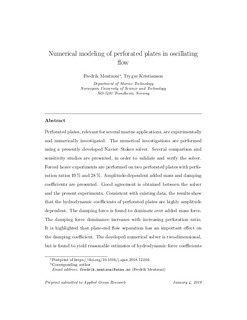| dc.contributor.author | Mentzoni, Fredrik | |
| dc.contributor.author | Kristiansen, Trygve | |
| dc.date.accessioned | 2019-01-05T12:55:04Z | |
| dc.date.available | 2019-01-05T12:55:04Z | |
| dc.date.created | 2019-01-04T08:58:02Z | |
| dc.date.issued | 2019 | |
| dc.identifier.citation | Applied Ocean Research. 2019, 84 1-11. | nb_NO |
| dc.identifier.issn | 0141-1187 | |
| dc.identifier.uri | http://hdl.handle.net/11250/2579327 | |
| dc.description.abstract | Perforated plates, relevant for several marine applications, are experimentally and numerically investigated. The numerical investigations are performed using a presently developed Navier–Stokes solver. Several comparison and sensitivity studies are presented, in order to validate and verify the solver. Forced heave experiments are performed on two perforated plates with perforation ratios 19% and 28%. Amplitude-dependent added mass and damping coefficients are presented. Good agreement is obtained between the solver and the present experiments. Consistent with existing data, the results show that the hydrodynamic coefficients of perforated plates are highly amplitude dependent. The damping force is found to dominate over added mass force. The damping force dominance increases with increasing perforation ratio. It is highlighted that plate-end flow separation has an important effect on the damping coefficient. The developed numerical solver is two-dimensional, but is found to yield reasonable estimates of hydrodynamic force coefficients when compared with a previous three-dimensional experimental investigation. This could indicate that three-dimensional effects are not dominant for the hydrodynamic forces of perforated plates, and that a two-dimensional viscous flow solver could have relevance as a tool for estimating hydrodynamic forces on three-dimensional perforated structures. | nb_NO |
| dc.language.iso | eng | nb_NO |
| dc.publisher | Elsevier | nb_NO |
| dc.rights | Attribution-NonCommercial-NoDerivatives 4.0 Internasjonal | * |
| dc.rights.uri | http://creativecommons.org/licenses/by-nc-nd/4.0/deed.no | * |
| dc.title | Numerical modeling of perforated plates in oscillating flow | nb_NO |
| dc.type | Journal article | nb_NO |
| dc.type | Peer reviewed | nb_NO |
| dc.description.version | acceptedVersion | nb_NO |
| dc.source.pagenumber | 1-11 | nb_NO |
| dc.source.volume | 84 | nb_NO |
| dc.source.journal | Applied Ocean Research | nb_NO |
| dc.identifier.doi | https://doi.org/10.1016/j.apor.2018.12.016 | |
| dc.identifier.cristin | 1650077 | |
| dc.description.localcode | © 2019. This is the authors’ accepted and refereed manuscript to the article. Locked until 4.4.2021 due to copyright restrictions. This manuscript version is made available under the CC-BY-NC-ND 4.0 license http://creativecommons.org/licenses/by-nc-nd/4.0/ | nb_NO |
| cristin.unitcode | 194,64,20,0 | |
| cristin.unitname | Institutt for marin teknikk | |
| cristin.ispublished | true | |
| cristin.fulltext | postprint | |
| cristin.qualitycode | 1 | |

